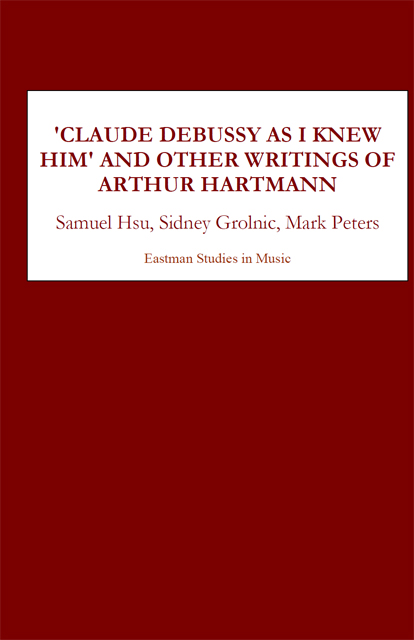Book contents
- Frontmatter
- Dedication
- Contents
- List of Photographs
- List of Facsimiles
- List of Music Examples
- List of Correspondence
- Foreword by David Grayson
- Preface
- Part 1 Arthur Hartmann
- Part 2 Claude Debussy
- Part 3 Other Writings of Arthur Hartmann
- Appendix A The Minstrels Manuscripts
- Appendix B Three Letters from Claude Debussy to Pierre Louÿs
- Arthur Hartmann: Catalogue of Compositions and Transcriptions
- Notes
- Archival Sources
- Bibliography
- Index
Charles Martin Tornov Loeffler
Published online by Cambridge University Press: 17 March 2023
- Frontmatter
- Dedication
- Contents
- List of Photographs
- List of Facsimiles
- List of Music Examples
- List of Correspondence
- Foreword by David Grayson
- Preface
- Part 1 Arthur Hartmann
- Part 2 Claude Debussy
- Part 3 Other Writings of Arthur Hartmann
- Appendix A The Minstrels Manuscripts
- Appendix B Three Letters from Claude Debussy to Pierre Louÿs
- Arthur Hartmann: Catalogue of Compositions and Transcriptions
- Notes
- Archival Sources
- Bibliography
- Index
Summary
Music Education Then and Now
In view of what music education has become today, with thousands of scholarships squandered and violinists graduating with but a limited—one might more truly say only a sectional—knowledge of the literature of their instrument, it is, I think, of interest to see what any violinist of my generation knew and had to know. In my particular case, it must be remembered that I had been a child prodigy and had already studied and played such works as the concerti of Rode, Kreutzer, de Bériot, Spohr, Mendelssohn, Beethoven (!), Molique, Bazzini, Vieuxtemps, and Lipinski, the now obsolete C-Major concerto of Saint-Saëns, the Romantique of Godard (with the composer in Paris), and a horde of other virtuoso pieces.
I no longer remember precisely with which etudes and concerto I started my work with Loeffler. But I do remember that if that first lesson was far from being a happy thing, it was not entirely disagreeable. He took everything to pieces, every bit and shred was criticized and analyzed both from the instrumental and the musical viewpoint. Fingerings, bowings, motives, phrases, sections, structure—everything and all came in for minute criticism followed by detailed explanation, and he did this during the better part of an afternoon without once having taken a violin in hand. This, I must say, was staggering and of profound value to me for the rest of my life, and I think that I should here record that during the two years or so that I worked with Loeffler, never did I hear him play, either in public or in giving me instruction. There was but one exception, and this will be related later in its proper place. Loeffler of course did play in public on rare occasions, usually in presenting one of his own works with the Boston Symphony Orchestra. But I aver again the peculiarity of my having had a teacher who never once gave me the living example in any kind of demonstration and whose tone I had never heard. I was unquestionably sure that his “technique”— that is to say, his left hand—had the distinction of any of the then famous violinists of the French School, but as to his tone I had a peculiar feeling that it was feeble and as colorless as his hair.
- Type
- Chapter
- Information
- Publisher: Boydell & BrewerPrint publication year: 2004

